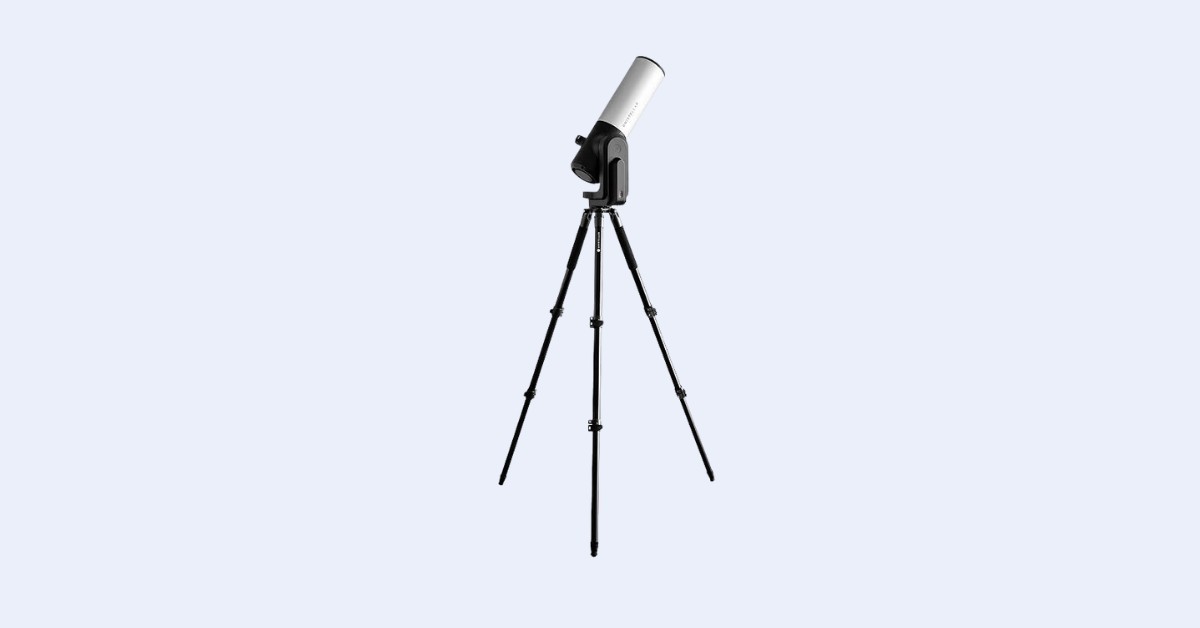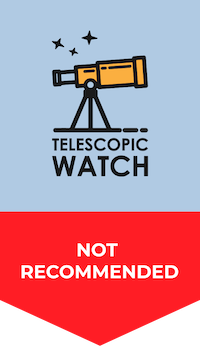eVscope 2’s Optical Tube Design
The Unistellar eVscope 2 is a simple 114mm f/3.9 reflector telescope with a 450mm focal length. It uses the same primary mirror as many inexpensive 114mm f/3.9 newtonian reflector telescopes, but replaces the secondary mirror in such telescope designs with a 7.7-megapixel Sony IMX347 CMOS camera sensor.
The double walls of the eVscope 2’s tube are constructed of thin aluminum on the outside and somewhat reflective satin black plastic on the inside, which can negatively amplify the glare and contrast loss of unwanted stray light.
At the end of the tube, instead of the typical secondary mirror found in Newtonian reflector telescopes, a central camera sensor is placed at the focal point of the eVscope 2’s primary mirror. A spider with four unusually thick vanes holds this sensor. As a result, the tube is slightly longer than the typical 114mm f/3.9 reflectors with which eVscope 2 shares its primary mirror.
The eVscope 2 is intended to capture images that can be viewed on a mobile device, but it also has a Nikon electronic “eyepiece” at the back of the tube, which is essentially just a round display with a loupe (the optics of this loupe are Nikon’s contribution).
If you ask me, the Nikon “eyepiece” doesn’t improve my viewing experience in any way. It is again not actually an eyepiece, and it even crops out some of the image edges due to the circular display, which is designed for aesthetic purposes.
The Lack of Autofocus
On the back of the telescope, there is a large plastic knurled knob that is used for focusing with the aid of the included Bahtinov mask.
It’s unfortunate that even with this new, more expensive version of the old eVscope, I still have to manually focus the scope when many of its competitors offer autofocusing capabilities.
Compared to the cost of this telescope (which is actually outrageous), adding the autofocus feature would have been incredibly cheap. I think requiring manual focusing pretty much ruins the idiot-proof design philosophy that the eVscope 2 attempts to achieve.
The Upgraded Camera Sensor and Its Power Consumption
The camera sensor is where the Unistellar eVscope 2 made the most improvements as compared to its predecessor, the original eVscope, and the trimmed-down eVscope eQuinox. eVscope 2 is equipped with a 7.7-megapixel Sony IMX347 CMOS camera sensor, which is a jump from the 4.9-megapixel IMX224 sensors of the original eVscope and eVscope eQuinox.
Unfortunately, there seems to have been zero thought put into the eVscope 2’s upgraded sensor when it comes to power consumption. Due to its greater power consumption, unfortunately, I got a battery life of just 9 hours at the first charge with the eVscope 2. In comparison, the eQuinox and the original eVscope have battery lives of 11 hours. 11 hours is already short; 9 hours is pitiful, and this is again with a brand-new unit under optimal conditions.
Unfortunately, the new sensor is still not cooled, which can result in high levels of noise during long exposures, but image stacking algorithms help with this. More on this later.
UniStellar App Capabilities
The included Unistellar software is a significant part of what we pay for when we purchase the eVscope 2 and is pretty much universal across all of the Unistellar models.
Available for both Apple and Android devices, the app enables me to do things like controlling the telescope’s movement/settings and viewing and saving images.
- The photo gallery tab lets me see my images.
- The telescope control tab prepares the telescope for pointing and observation. While the automatic alignment of the eVscope is usually very accurate at centering objects on the first try, I’ve sometimes experienced that it fails when the star field is not dark enough or is obscured by clouds.
- The settings tab at the top right lets me adjust my photo-saving options, focus, orientation, and sensor calibration while monitoring the telescope’s battery life and storage capacity.
One of the other neatest features of the app is the ability to contribute to scientific observations, such as tracking asteroid occultations, exoplanet transits, comets, and more. All I had to do was sign up for membership (free) and download coordinates from the Unistellar website.
To connect the eVscope to the app, the telescope creates a wireless access point in the form of a discoverable wifi network, which my smartphone or tablet can then connect to from distances up to a few hundred feet away. From there, the Unistellar app uses my GPS location to orient itself. Its sky catalog provides information and allows me to slew to over 5,000 objects, while also letting me filter and sort them based on their type or proximity to the telescope’s current location.
The Good & Bad of the Mount
The eVscope 2 is supplied with a fairly sturdy camera tripod and a motorized fork arm that securely holds the tube.
Setting up the telescope is a breeze due to its simple design. I just have to unfold the tripod, level it, and attach the telescope to the tripod head.
Similar to the eVscope eQuinox, the telescope is secured to the tripod head with just two thumb screws spaced 120 degrees apart from each other. I think it is a poor design choice and may allow for some unwanted shifting on the head. If you ask me, adding a third thumbscrew would have been an easy task for Unistellar to do when they designed this second version of eVscope, but they did not seem to bother.
Unistellar also seemed to take inspiration from the now-discontinued Meade ETX with the black plastic fork mount. Considering its high price tag, I’m extremely disappointed that the fork mount is made of plastic, as it seems susceptible to damage if the telescope were to fall or get hit by something.
The Undesirable “Live Stacking” Performance
- The Sony IMX347 sensor in the eVscope 2 is not cooled, resulting in increased noise levels, particularly during long exposures.
- The alt-azimuth design of the telescope’s mount leads to image blurring due to insufficient tracking accuracy and “star-step” motion across the sky.
The eVscope 2 attempts to mitigate these two issues by stacking multiple short exposures and thereby minimizing noise buildup, though it doesn’t entirely solve the problem.
Unistellar refers to this as “enhanced vision technology,” which is misleading. They haven’t developed any groundbreaking technology. They are simply employing the well-established astrophotography technique of stacking, specifically “live stacking” of short exposures over the course of a few minutes.
While stacking is a fundamental component of deep-sky astrophotography, genuine astrophotography employs a better-optimized camera sensor, hours-long total exposure times, and extensive post-processing. In contrast, in the case of eVscope 2, live stacking exposures of a few minutes with an uncooled sensor and real-time automated processing are bound to disappoint. It falls short of genuine astrophotography.
It also lacks the dynamic range or contrast of actual visual observation and prevents us from directly observing the objects themselves. The photons that have traveled thousands, millions, or even billions of light-years never directly enter our eyes.
Images produced by the eVscope 2 are not half bad, but they are not even close to what a sophisticated astrophotography rig at a similar (or even far cheaper) price point could produce. However, the primary selling point of this telescope is its convenience rather than its quality.
Field Of View: Better, But Still Not Good
Because of the larger IMX347 sensor, we get a field of view of approximately 34 x 47 arcminutes with the eVscope 2, which is up from the original eVscope and eQuinox’s 27 x 37 arcminute field of view. But it is still tiny—not much bigger than the full Moon (30 x 30 arcminutes) and quite a bit smaller than the area many deep-sky objects take up in the sky.
For comparison, a 1.25” eyepiece coupled to a typical 450mm focal length telescope (such as the Celestron StarSense Explorer 114mm Tabletop Dobsonian, which uses the same primary mirror as the eVscope 2) can get a field of view 3.5 degrees across. This is close to 5x the field of the eVscope’s long axis and over 5x the field I get when looking through its fake “eyepiece.” Even a typical APS-C camera sensor with a 450mm focal length telescope can achieve a similar, if not quite as wide, field of view.
Should I buy a Used Unistellar eVScope 2?
Since the eVscope 2 is an entirely integrated system, any malfunction can render the entire device inoperable. The components are not easily replaceable or repairable, making it unwise to purchase a used unit.
Unistellar offers a 2-year warranty from the purchase date that covers second-hand purchases as well. However, this warranty is void if the telescope has been tampered with or modified in any way, which can be difficult to ascertain when purchasing a pre-owned device.
Alternative Recommendations
At this price point, there are many telescopes that are larger or pack more features than the eVscope 2, but at the cost of portability and ease of use.
There are no direct alternatives to the eVscope 2, as it is not a product one would want to replicate. But depending on your priorities, there may be some options for you to consider.
I’ve picked the products below as just a small sampling, but feel free to check out our telescope rankings. Our OTA and mount
- The Vaonis Stellina is a similar all-in-one package to the eVscope 2, but is actually designed for a serious user. It’s more compact, easier to use, has a wider field, and actually has autofocus capabilities, while also avoiding the false promises and silly fake eyepiece of the eVscope 2. It’s an all-in-one astrophotography rig and isn’t trying or pretending to be anything else.
- The Vaonis Vespera is a smaller version of the Stellina with a shorter focal length and a wider field of view, as well as a lower price.
- The Celestron Nexstar Evolution 8 is a lot bulkier than the eVscope 2, but also has a decent built-in battery and WiFi. Despite not coming with one, you can still attach a cheap planetary camera to it and take better planetary images than the eVscope 2 could ever dream of. Deep-sky imaging is also possible by putting the scope on a different mount and adding in some aftermarket kit.
- The Sky-Watcher Virtuoso GTi 150P is one of the cheapest GoTo options on the market but is surprisingly comparable to the eVscope 2, although without the camera, of course. However, a small, lightweight planetary camera can be used for basic astrophotography.
Aftermarket Accessory Recommendations
There are not many accessory recommendations we can offer for the eVscope 2 since it is a self-contained package, but Unistellar offers a travel backpack for it. However, the Unistellar backpack is excessively expensive for what it is, so we suggest just purchasing a basic padded case or backpack that can accommodate it instead.
On humid nights, dew has the potential to be a problem if it forms on the sensor, so it’s advisable to purchase a wrap-around dew shield to prevent condensation from collecting on the camera sensor and interfering with the telescope’s operation.




After several months my eVscope stopped turning on. This telescope has a structural flaw : the battery dies after 2 months if not recharged ! Unistellar support is awful, saying that keeping it safe several months in its backpack is an “inappropriate us” and breaks the warranty ! a shame for a 5000$ product : stay away from it !
I couldn’t agree more with your intro. This scope is usually a ”first purchase” for people who discover smart scope and haven’t really made their due diligence. There are now so many much better and much better scopes out there: Seestar, Vaonis, Dwarf…
I used to have an Evscope2, I got rid of it for a half-priced Vaonis Vespera 2. It’s just another world. The images are a million times better and the scope is flawless. I had so many issues with the EV2, enhanced vision disrupted al the time for no reason, collimation issues, focus issues…. this scope is just a nightmare. While it;s not too bad with clusters and galaxies, it’s absolutely useless for nebulae (even with a dual band filter). It’s absolutely outrageous how bad it is for nebulae. Just a disaster, a joke… and their last VVT ”technology” is even worse..
Avoid at all cost… go with a Seestar S50 if you have limited budget or with a Vespera 2.